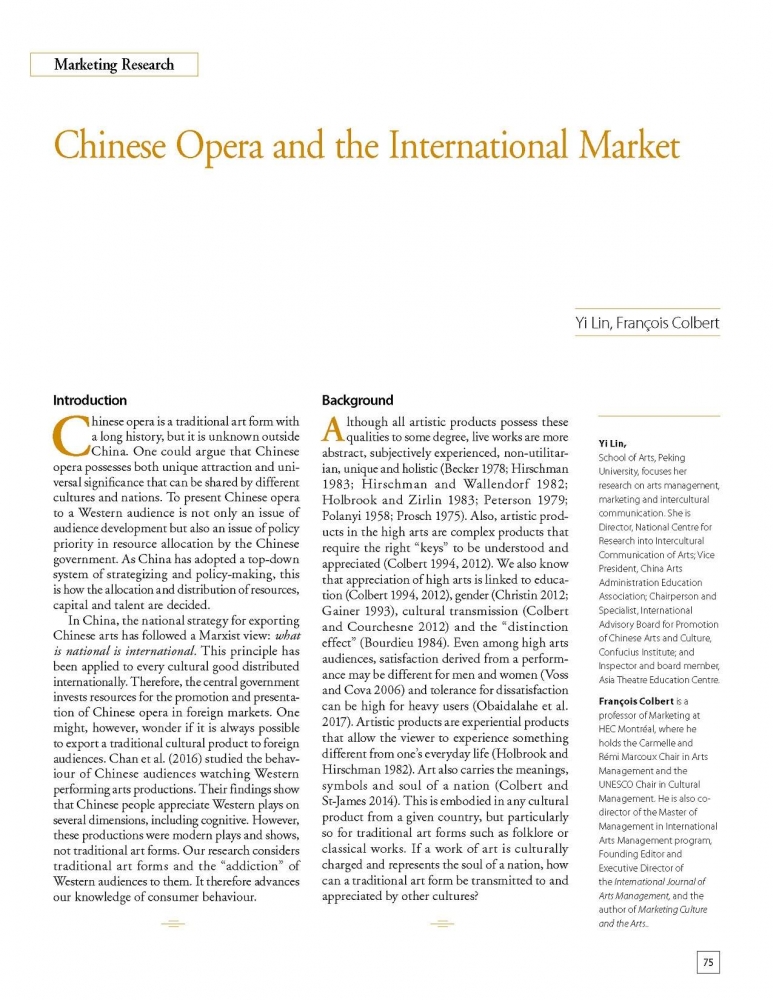Chinese Opera and the International Market
Produit: Article
21,00 $ CA
Yi Lin, François Colbert
Yi Lin, School of Arts, Peking University, focuses her research on arts management, marketing and intercultural communication. She is Director, National Centre for Research into Intercultural Communication of Arts; Vice President, China Arts Administration Education Association; Chairperson and Specialist, International Advisory Board for Promotion of Chinese Arts and Culture, Confucius Institute; and Inspector and board member, Asia Theatre Education Centre.
François Colbert is a professor of Marketing at HEC Montréal, where he holds the Carmelle and Rémi Marcoux Chair in Arts Management and the UNESCO Chair in Cultural Management. He is also codirector of the Master of Management in International Arts Management program, Founding Editor and Executive Director of the International Journal of Arts Management, and the author of Marketing Culture and the Arts.
ABSTRACT
In 1983 Elizabeth C. Hirschman published what was to become a classic work on marketing strategies for aesthetic and ideological products. She constructed three circles, with the public in the outer circle, peers and industrial professionals in the middle circle, and artists in the inner circle. She stated that artists may hope or want to reach one or another of the three segments, or even all three at once. In 1994, based on Hirschman’s three-segment theory, François Colbert proposed that the product-centred marketing process is distinct from the traditional market-centred process of finding consumers who are likely to appreciate the product. Both Hirschman and Colbert offer a conceptual basis for analyzing the arts market. This article reports on a strategic analysis of the international market for Chinese opera based on experimental data. It extends Hirschman’s analysis in several ways: (1) it introduces a quantitative element to support her three-circle classification; (2) it reveals the interactive relationship among the three circles; and (3) it builds a potential strategic system for the development of an international market for Chinese opera. The article also offers insights into the Chinese government’s policies on the export of traditional art.
KEYWORDS
Strategic analysis, international market, audience segmentation, Chinese opera
RÉSUMÉ
En 1983, Elizabeth C. Hirschman a publié ce qui deviendrait plus tard un ouvrage classique sur des stratégies de marketing visant des produits esthétiques et idéologiques. Elle a imaginé trois cercles concentriques: le cercle extérieur contenait le public, les pairs et les professionnels de l’industrie se trouvaient dans le cercle du milieu et les artistes étaient dans le cercle intérieur. Elle affirmait qu’il était possible que les artistes veuillent rejoindre l’un ou l’autre des trois segments, ou même tous les trois à la fois. En 1994, en s’appuyant sur la théorie des trois segments élaborée par Hirschman, François Colbert a proposé l’idée que le processus de marketing axé sur le produit est distinct du processus traditionnel qui est axé sur le marché, c’està-dire sur la recherche de consommateurs susceptibles d’aimer le produit. Le cadre conceptuel proposé par Hirschman et Colbert permet d’analyser le marché des arts. Cet article rend compte d’une analyse stratégique du marché international pour l’opéra chinois, et ce, en s’appuyant sur des données expérimentales. Il augmente la portée de l’analyse de Hirschman de plusieurs façons : (1) il apporte un élément quantitatif pour appuyer sa classification divisée en trois cercles; (2) il fait ressortir la relation interactive entre les trois cercles; (3) il propose une approche stratégique potentielle en vue de développer un marché international pour l’opéra chinois. Finalement, cet article aide à mieux comprendre les politiques du gouvernement chinois en matière d’exportation de l’art traditionnel.
MOTS CLÉS
Analyse stratégique, marché international, segmentation des publics, opéra chinois
RESUMEN
En 1983, Elizabeth C. Hirschman publicó lo que se volvería un trabajo clásico sobre las estrategias de mercadotecnia para los productos estéticos e ideológicos. Ella construyó tres círculos, con el público en el círculo exterior, los homólogos y profesionales de la industria en el círculo del medio, y los artistas en el círculo interior. Declaró que los artistas pueden esperar o querer llegar a uno de los tres segmentos, o incluso a los tres a la vez. En 1994, basándose en la teoría de los tres segmentos de Hirschman, François Colbert sugiere que el proceso de mercadotecnia centrado en el producto se distingue del proceso tradicional centrado en el mercado, que busca consumidores que probablemente apreciarán el producto. Tanto Hirschman como Colbert dan una base conceptual para el análisis del mercado de las artes. Este artículo trata de un análisis estratégico del mercado internacional para la ópera china basada sobre datos experimentales. Extiende de varias maneras el análisis de Hirschman: (1) introduce un elemento cuantitativo en apoyo de la clasificación en tres círculos; (2) revela la relación interactiva entre los tres círculos; (3) crea un sistema estratégico potencial para el desarrollo de un mercado internacional para la ópera china. El artículo informa a su vez sobre las políticas del gobierno chino en materia de exportación de arte tradicional.
PALABRAS CLAVE
Análisis estratégico, mercado internacional, segmentación de público, ópera china

